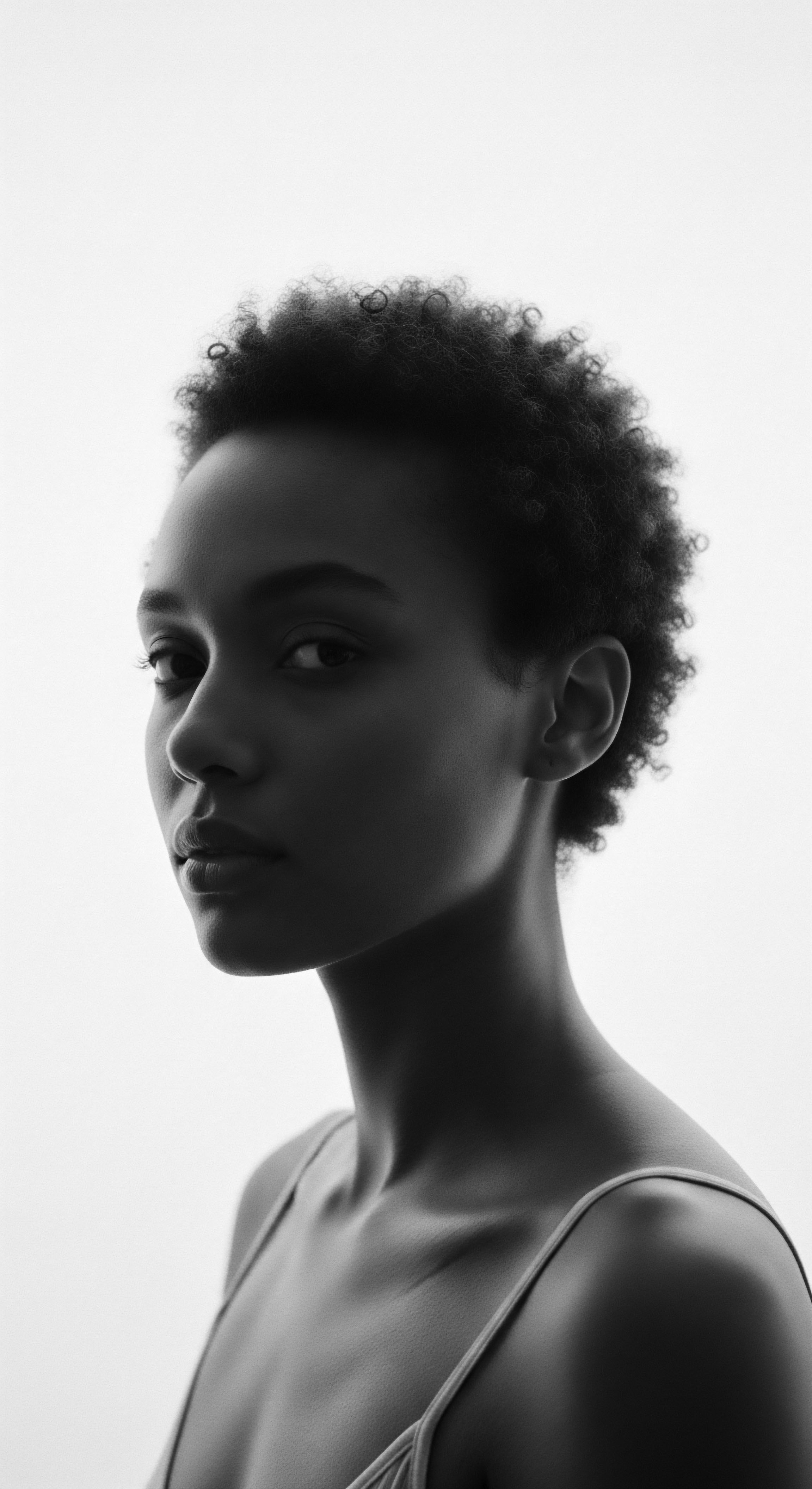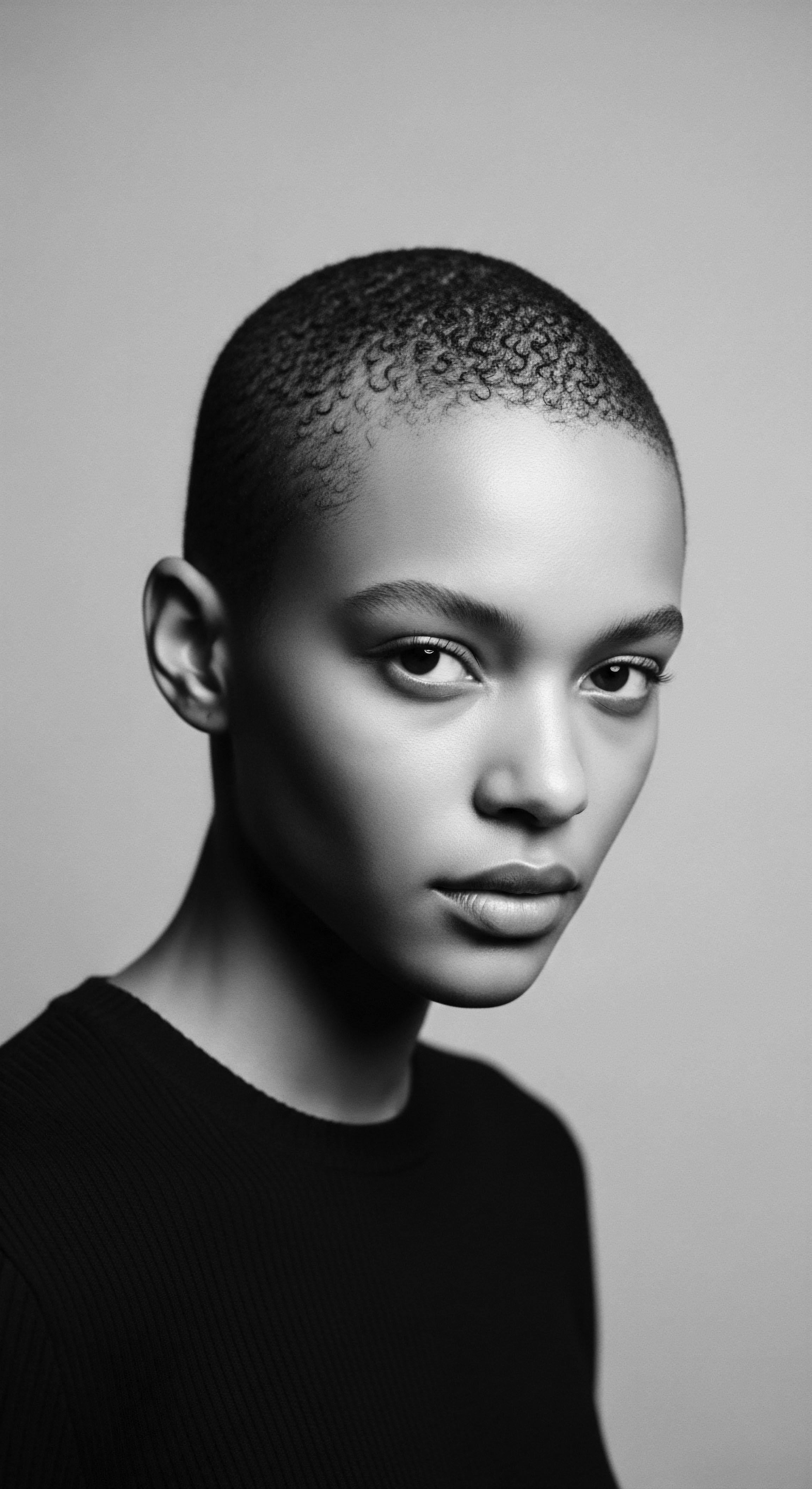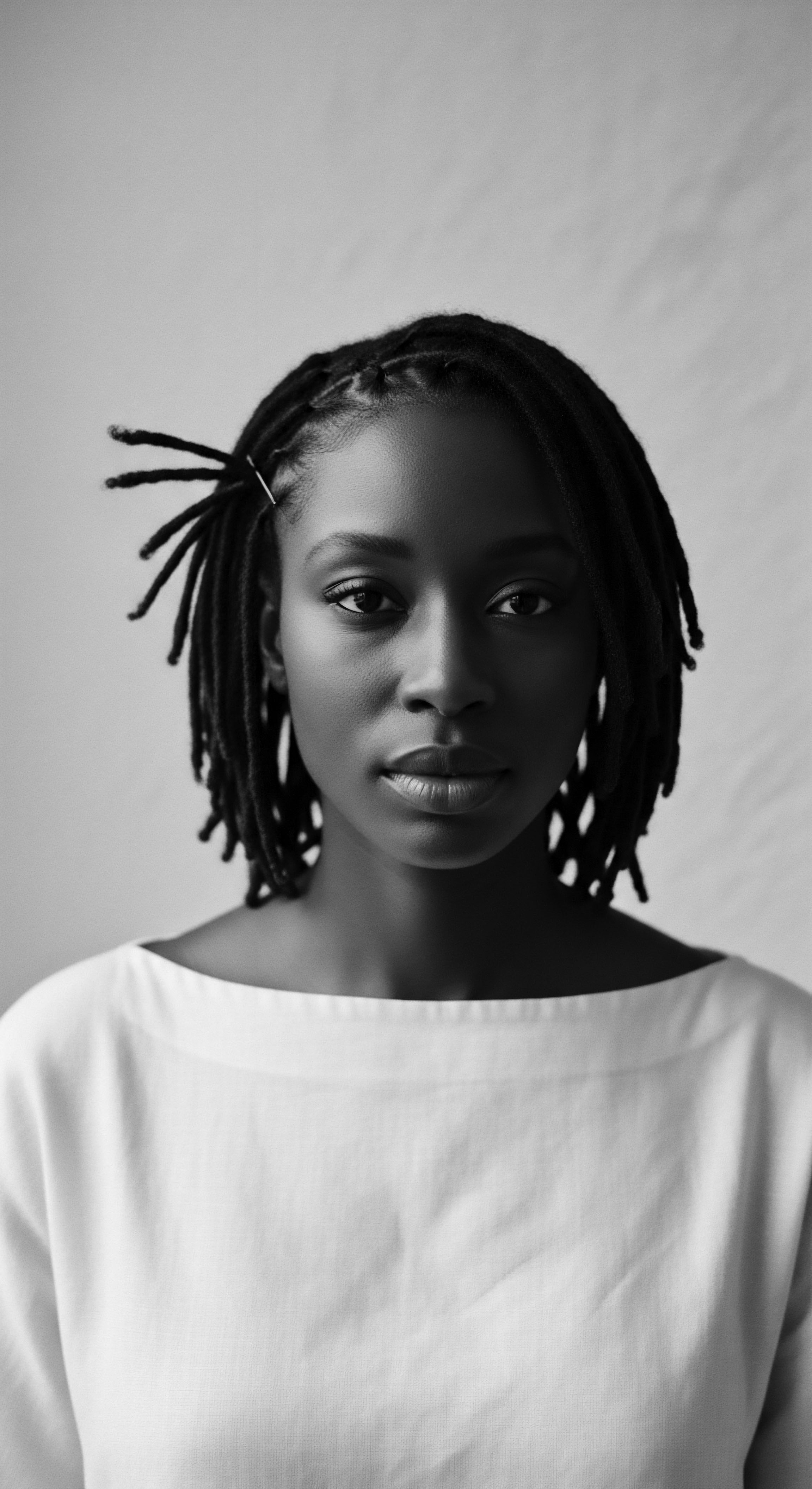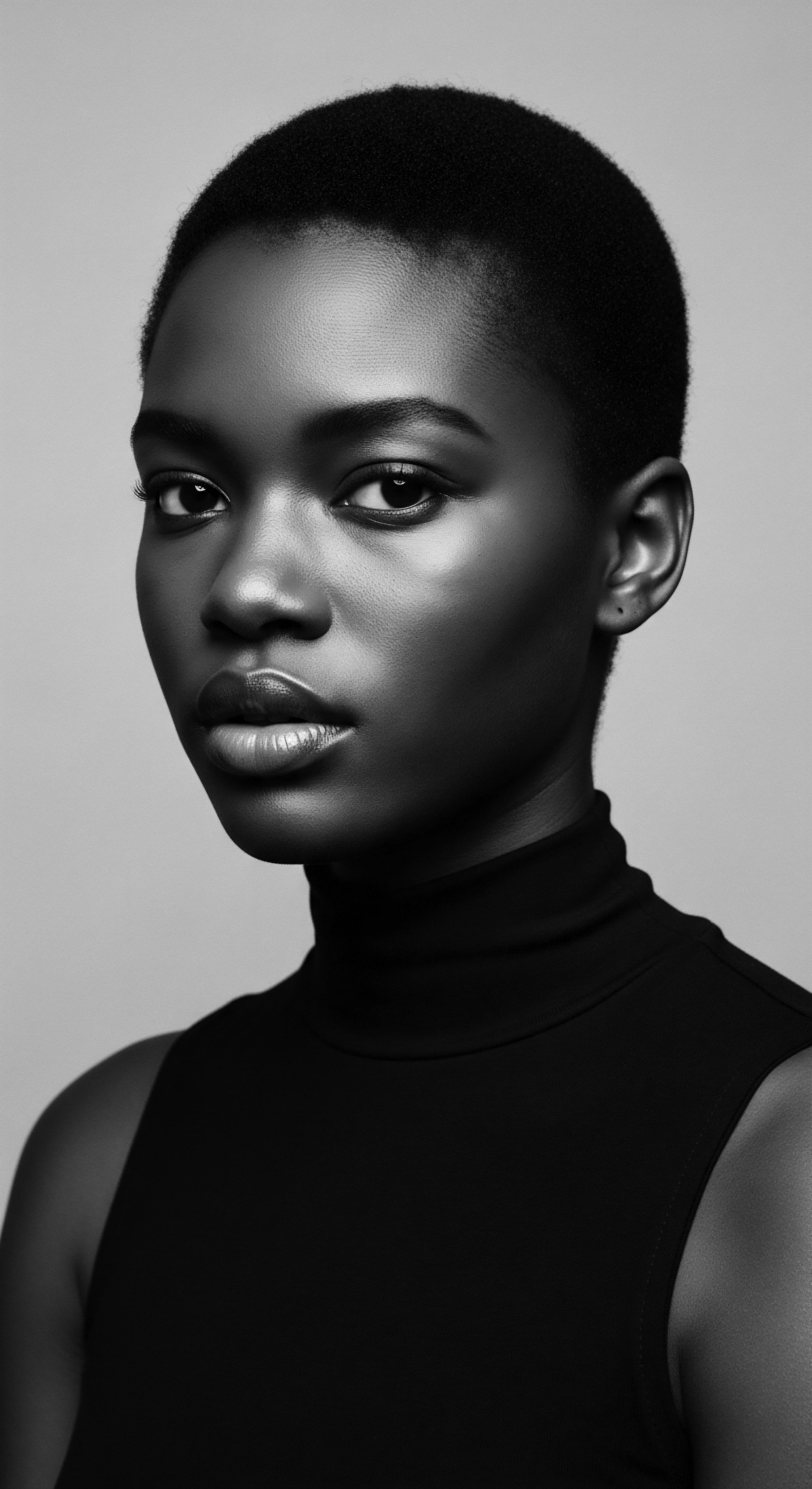
Roots
To truly understand the journey of textured hair self-acceptance, one must first step back, far back, into the very origins of our collective memory, where strands were not merely adornments but vibrant symbols of identity, belonging, and spiritual connection. For countless generations, across the vast and varied lands of Africa, hair served as a living archive, a scroll upon which stories of lineage, status, age, and spiritual wisdom were etched. The relationship between African peoples and their hair was, from ancient times, one of profound reverence, a sacred bond that spoke volumes without a single uttered word.
Before the harrowing ruptures of the transatlantic slave trade, the manipulation of hair was a sophisticated art, passed down through the hands of elders and gifted practitioners. Archaeological evidence, from the intricate depictions in ancient Egyptian tombs to the detailed sculptures of the Kingdom of Kush, reveals hair styled in ways that communicated power and community ties. Kushite culture, for instance, celebrated natural hair textures, with individuals often styling their hair in tight coils or meticulously formed rows, embodying a distinct Nubian aesthetic.
(Afriklens, 2024). This historical reverence for natural texture stands as a powerful testament to a time when hair was understood as a direct link to one’s spiritual essence and ancestral guides.

What Did Ancient Hair Styles Convey?
In pre-colonial African societies, hair styling was a language unto itself, a complex system of communication that transcended mere appearance. Each twist, braid, or adornment could convey a person’s life story, their place within the community, or their spiritual allegiances. It was a visible manifestation of one’s inner world and outer responsibilities.
- Social Standing ❉ The intricacy and height of a hairstyle often signified a person’s wealth, marital status, or leadership role within their tribe.
- Age and Transition ❉ Specific styles marked rites of passage, like entering adolescence, marriage, or motherhood, signifying significant life changes.
- Spiritual Connection ❉ Many African cultures regarded the head as the closest point to the divine, a portal for spiritual energy. Therefore, hair, as the highest part of the body, was treated with utmost care, often adorned with elements intended to honor ancestors or invite blessings.
- Tribal Affiliation ❉ Distinctive patterns and techniques identified one’s ethnic group, acting as visual markers of kinship and shared heritage across diverse communities.
The very act of hair grooming was a communal ritual, a time for intergenerational bonding and the transmission of knowledge. These were moments of shared laughter, quiet storytelling, and gentle hands tending to the strands, reaffirming familial and community bonds. The time invested in these processes, often stretching for hours or even days, underscored the deep cultural significance and the communal aspect of hair care in these societies (Afriklens, 2024).
The history of Black hair also bears witness to the harrowing impact of colonization and enslavement. Upon arrival in the Americas, a cruel, systematic act of dehumanization began ❉ enslaved Africans were often forced to shave their heads. This was a deliberate attempt to strip them of their identity, severing visible ties to their homelands, tribes, and families. Yet, even in the face of such profound violence, the spirit of textured hair persisted, silently asserting its enduring presence.
Textured hair, from ancient times, was a profound cultural script, telling stories of identity, status, and spiritual connection through each curl and coil.
This systematic erasure, however, could not extinguish the deep-seated reverence for hair. Enslaved Africans, with remarkable resilience and ingenuity, found ways to preserve their hair traditions. They used whatever limited resources were available—natural oils, improvised combs fashioned from found objects, even their own fingers—to maintain their strands. These acts of care, however simple, became powerful gestures of self-preservation, a quiet defiance against the forces that sought to obliterate their ancestral memory.
The very texture of Black hair, often denigrated as “nappy” or “wooly” by enslavers, became a tool of resistance. Cornrows, a style deeply rooted in African heritage, took on a new, urgent purpose. Enslaved women would braid intricate patterns into their hair that were not merely decorative. They served as clandestine maps, charting escape routes to freedom or indicating safe houses along the Underground Railroad (Thrifts & Tangles, 2021).
Within these tightly woven patterns, they concealed seeds of rice and other grains, a powerful act of carrying their ancestral lands and future sustenance within their very being, ready to plant new life upon reaching liberation (BLAM UK CIC, 2022). This profound historical example shows how hair became a literal and symbolic vessel for survival and cultural continuity, a testament to the indomitable will of a people to maintain their heritage even under the most brutal conditions.

Ritual
The journey of textured hair self-acceptance did not halt with liberation; rather, it transformed, adapting to new landscapes while continuing to draw strength from its ancestral wellspring. As communities of Black and mixed-race people formed across the diaspora, the practices surrounding hair evolved, becoming deeply interwoven with daily rituals, communal gatherings, and expressions of identity. These rituals, whether the quiet moments of care in a household or the vibrant energy of a salon, represent a continuation of the tender thread that binds present to past.

What Did Black Hair Rituals Become After Enslavement?
Following the era of chattel slavery, the significance of hair in Black communities gained new dimensions. While the immediate threat of forced shaving subsided, a new form of oppression emerged ❉ the imposition of Eurocentric beauty standards. Straight hair became associated with respectability, social mobility, and even economic advancement, leading many to seek ways to alter their natural textures.
This era saw the rise of hair straightening practices, sometimes involving harsh lye-based chemicals or hot combs that could cause damage (JSTOR Daily, 2019). Yet, even within this complex landscape, figures arose who understood the deeper needs of their communities.
Among the earliest and most impactful of these figures were pioneering Black women entrepreneurs like Annie Turnbo Malone and Madam C.J. Walker. Born to formerly enslaved parents in the late 19th century, these women recognized a critical gap in the market for products formulated specifically for textured hair. Their work went beyond mere commerce; it became a vehicle for self-care, economic empowerment, and a quiet assertion of Black beauty.
Annie Turnbo Malone, for instance, established the Poro College Company in 1902 in Missouri (National Museum of African American History and Culture, 2011). This institution was not simply a cosmetology school; it served as a community hub, training thousands of Black women in hair care and enabling them to build financial independence in a segregated society (Odele Beauty, 2021).
| Figure Annie Turnbo Malone |
| Contribution to Hair Care Heritage Developed scalp preparations and hair-growth formulas; founded Poro College, training Black women in hair care and business, creating economic opportunities. |
| Figure Madam C.J. Walker |
| Contribution to Hair Care Heritage Pioneered the "Walker system" of hair care for Black women, building a vast enterprise that provided self-care solutions and financial liberation for her sales agents. |
| Figure These figures transformed the landscape of Black beauty, weaving economic agency into the very fabric of hair care. |
Madam C.J. Walker, a protégée of Malone, built upon this foundation, creating an expansive beauty empire that made her America’s first recognized self-made female millionaire (HISTORY, 2009). Her “Walker system” of hair care, including scalp treatments and specialized pomades, addressed the specific needs of Black women’s hair, offering solutions that were both effective and accessible.
While some historical perspectives discuss her promotion of hair straightening, it is crucial to recognize that her focus was also on scalp health and providing Black women with options for managing their hair, empowering them to feel confident in a society that often devalued their natural appearance (childish mane llc, 2024; VOA, 2004). Her network of “Walker Agents”—primarily African American women—not only sold products but also became ambassadors of empowerment within their communities, fostering a sense of collective pride and self-sufficiency (Fashionista, 2022).
The rise of Black beauty entrepreneurs like Annie Turnbo Malone and Madam C.J. Walker transformed hair care into a powerful vehicle for economic empowerment and community building.
The salon became a sanctuary, a place where stories were exchanged, wisdom was shared, and a sense of belonging deepened. This communal aspect of hair care, echoing ancient African traditions, offered a respite from a world that often sought to diminish Black identity. The practices of washing, oiling, braiding, and twisting became not just about grooming but about reaffirming cultural ties and creating spaces of affirmation.
Protective styles, such as braids, twists, and locs, which had served as practical and symbolic expressions for millennia in Africa, continued their evolution. They offered ways to manage textured hair, promote health, and simultaneously express cultural pride. These styles allowed individuals to maintain their ancestral aesthetic while navigating the social realities of their time. The continuity of these practices, often learned at the knee of an elder, speaks to an enduring cultural memory and the quiet strength found in maintaining one’s heritage.

Relay
The journey of textured hair self-acceptance gained profound momentum in the mid-20th century, particularly with the Civil Rights and Black Power movements. This period witnessed a powerful reassertion of Black identity, where hair became a visible declaration of pride and a rejection of imposed beauty standards. This was a time when individual choice became a collective statement, transforming personal grooming into a political act.

How Did the Black Power Movement Shape Hair Acceptance?
As the call for civil rights intensified, a concurrent movement for cultural liberation took root. The “Black is Beautiful” movement, gaining prominence in the 1960s, served as a rallying cry, urging Black individuals to affirm the inherent beauty of their skin, features, and especially, their natural hair (Creative Support, 2023; Odele Beauty, 2021). Figures who championed this sentiment often found themselves at the forefront of a cultural shift.
One such voice was Marcus Garvey, who, much earlier in the 20th century, had already laid conceptual groundwork for Black self-acceptance. He urged Black women to embrace their natural kinks, famously stating, “Don’t remove the kinks from your hair! Remove them from your brain!” (JSTOR Daily, 2019).
This sentiment underscored a deeper understanding that true liberation required a mental and spiritual release from Eurocentric aesthetic norms. Garvey’s words, though predating the mainstream “Black is Beautiful” movement, resonate with its core message of self-acceptance rooted in racial pride.
The Afro hairstyle became an iconic symbol of this era, a voluminous crown worn proudly as a sign of Black pride, power, and resistance against oppression (BLAM UK CIC, 2022; Thrifts & Tangles, 2021). Activists like Angela Davis, with her distinctive Afro, embodied this defiance (CBC Radio, 2021). Her natural hair was not simply a style; it was a potent political statement, challenging prevailing norms and inspiring countless others to shed chemical straighteners and embrace their curls. The Afro stood as a stark visual counterpoint to centuries of denigration, proclaiming that Black hair, in its unadulterated state, was indeed beautiful.
The intellectual and artistic expressions of the Harlem Renaissance also played a significant role in this ongoing dialogue, even decades before the “Black is Beautiful” slogan became widespread. Writers such as Gwendolyn B. Bennett and Helene Johnson challenged the prevailing beauty ideals of their time, asserting a distinct Black aesthetic in their work (The Metropolitan Museum of Art, 2024; Open Space, 2017).
Their poetry and prose, though often subtle, chipped away at the ingrained notion that European features and hair textures were the sole measures of beauty. They contributed to a nascent movement of self-definition that would later blossom into a full-fledged cultural revolution.
The Civil Rights and Black Power movements catalyzed a profound shift, transforming natural hair into a powerful emblem of Black pride and resistance.
The societal impact of embracing natural hair was not without its challenges. Even as the movement gained traction, individuals faced discrimination in schools and workplaces (ResearchGate, 2020). Despite such pressures, the movement continued to grow, fueled by a collective desire for authenticity and self-determination.
Research indicates that Black women who embrace their natural hair often experience positive hair and self-esteem profiles, suggesting a direct link between natural hair acceptance and overall well-being (PubMed, 2020; eScholarship.org, 2023). This reinforces the understanding that self-acceptance of textured hair extends beyond aesthetics, impacting mental and physical health.

Did Natural Hair Acceptance Influence Wellness?
The journey towards self-acceptance for textured hair also encompasses a deep understanding of its biological characteristics and the holistic care it requires. Modern science, in many instances, validates and provides deeper insights into long-standing traditional practices, reinforcing the wisdom of ancestral approaches. The unique structure of textured hair, with its elliptical follicle and distinctive curl pattern, necessitates specific care to maintain its health and vibrancy. This knowledge, when married with heritage practices, allows for a comprehensive approach to hair wellness.
Consider the practice of oiling. Ancient African communities used natural oils like shea butter and coconut oil to moisturize and protect hair from environmental stressors (Salford Students’ Union, 2024). Today, scientific understanding confirms the benefits of these natural lipids in sealing moisture, preventing breakage, and supporting scalp health. This intersection of ancestral wisdom and scientific validation provides a powerful framework for holistic hair care, fostering a deeper connection to one’s heritage through mindful self-care.
Another testament to the enduring impact of historical figures and movements is the continued presence of headwraps. While initially imposed by laws like Louisiana’s Tignon Law in 1786, which forced Black women to cover their hair as a marker of inferior status, these women defiantly transformed the headwrap into a statement of identity and creativity (Thrifts & Tangles, 2021; Wikipedia, 2024). They used colorful, ornate fabrics, turning an act of oppression into a vibrant cultural expression. This legacy persists today, with headwraps serving as both a practical protective style and a powerful symbol of cultural pride and ancestral connection.
The figures who shaped textured hair self-acceptance—from the unnamed enslaved women who braided secret maps into their hair, to entrepreneurial pioneers like Annie Turnbo Malone and Madam C.J. Walker, to defiant activists like Angela Davis—demonstrate a continuous relay of resilience, innovation, and self-definition. Each individual, whether through overt rebellion or quiet perseverance, contributed to a collective heritage of affirming textured hair as a source of strength, beauty, and identity.
- Cornrow Maps ❉ During slavery, cornrows were braided in specific patterns to chart escape routes and conceal seeds, making hair a tool of survival and cultural preservation.
- Malone’s Poro College ❉ Annie Turnbo Malone established educational institutions that empowered Black women with professional skills and economic independence through hair care.
- Angela Davis’s Afro ❉ The Afro hairstyle, popularized by figures like Angela Davis, became a symbol of political resistance and a celebration of natural Black beauty during the Black Power era.

Reflection
The journey of textured hair self-acceptance is a narrative deeply etched into the very core of shared heritage, a story that continues to unfold with each generation. From the communal rituals of ancient African civilizations to the defiant artistry of enslaved peoples, and onward to the entrepreneurial spirit of beauty pioneers and the revolutionary statements of civil rights activists, textured hair has consistently mirrored the resilience, creativity, and profound identity of Black and mixed-race communities. It stands as a living testament to an unbreakable spirit, a visible manifestation of ancestral wisdom woven into modern life.
The legacy of those who championed this acceptance continues to guide us, reminding us that every strand holds a story, a connection to a deep, unbroken lineage of strength and beauty. We honor this living archive by embracing our hair in its truest form, understanding that its acceptance is a powerful act of self-love, a celebration of heritage, and a beacon for the future.

References
- Afriklens. (2024). African Hairstyles ❉ Cultural Significance and Legacy.
- BLAM UK CIC. (2022). The History of Black Hair.
- CBC Radio. (2021). Tangled Roots ❉ Decoding the history of Black Hair.
- childish mane llc. (2024). Crowning Glory ❉ Madame CJ Walker’s Hair Products and Her Legacy of Black Entrepreneurialism.
- Creative Support. (2023). The History of Black Hair.
- eScholarship.org. (2023). The Development Of A Self- Esteem Toolkit For Black Adolescent Girls Centering Hair As A.
- Fashionista. (2022). In Black Hair Care, Innovation Does Not Exist Without History.
- HISTORY. (2009). Madam C. J. Walker ❉ Products, Hair & Facts.
- JSTOR Daily. (2019). How Natural Black Hair at Work Became a Civil Rights Issue.
- National Museum of African American History and Culture. (2011). Annie Malone and Madam C.J. Walker ❉ Pioneers of the African American Beauty Industry.
- Odele Beauty. (2021). 6 Things Everyone Should Know About Black Hair History.
- Open Space. (2017). The Black Aesthetic (Anchor Books, 1972).
- PubMed. (2020). Natural Hair ❉ a Vital Component to Black Women’s Health.
- Salford Students’ Union. (2024). The Remarkable History Behind Black Hairstyles.
- The Metropolitan Museum of Art. (2024). Harlem Is Everywhere ❉ Episode 3, Art & Literature.
- Thrifts & Tangles. (2021). The Evolution of Black Hair for Beauty & Resistance.
- VOA. (2004). Madam CJ Walker Revolutionized Hair Care for African American Women.
- Wikipedia. (2024). Discrimination based on hair texture.
